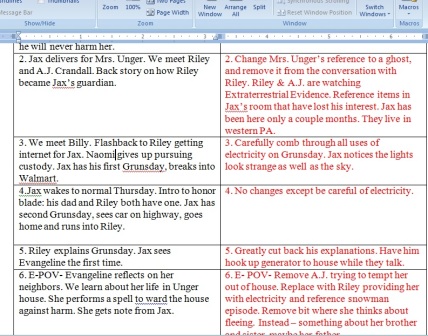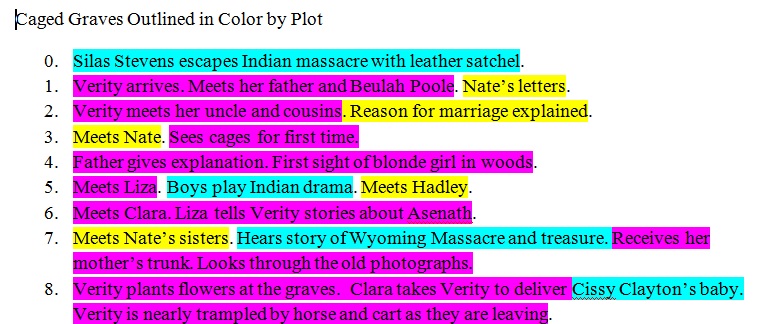So many people commented on Yvonne Ventresca’s strategy of reverse outlining last week that I decided to share my techniques for “post draft outlining.”
By the time I type THE END on a first draft, I know all the things that are wrong with it, which may include:
- Important information I never found a place to insert
- Important information I inserted in several places, not sure which place would be best
- Plot holes
- Unnecessary side plots, characters, or clues I never ended up needing
- Inconsistent details in setting or world building
- Wavering character motivation
- Pacing
- Character changes (In the first draft of The Caged Graves, the character of Beulah Poole started out as a teenage girl. I realized about two thirds of the way through the first draft that I needed her to be an old woman!)
Immediately after the first draft, I create a side-by-side outline to guide my second draft revisions. In one column, I list the important events in each chapter. In the other column, I note what changes I’ll need to make. These include all the things I listed above, as well as events to delete or re-order and chapters that need to be combined or split apart.
In the case of The Caged Graves, a historical murder mystery, I also created an even briefer outline of the events in each chapter and color coded them: purple for the mystery of the graves, yellow for Verity’s romance, blue for the mystery of the Revolutionary War treasure. This helped me adjust the pacing and make sure that the main mystery remained in the forefront of the story, with the romance providing a counter-point and the secondary mystery appearing often enough to not be forgotten. If I found that one color took over an entire section of the story, or if one color disappeared for too long, I made notes on how to fix it.
Anyone else have an outlining (pre- or post-) to share?


Loved hearing about your outlining process. I have used your second outline idea when drafting a manuscript. I add the brief outline as I go and switch things around as I go back and edit. I really like your side-by-side outline idea too.
My outlines are quite similar, although I usually write them as I go or a little bit ahead if I know exactly exactly what’s going to happen in the next chapter. Then I go back and add blue notes to the outline which highlight any issues or changes.
Hi Dianne – I love your ideas … and I’m sure if I wrote novels or books … I’d be outlining. I always read magazines backwards – don’t ask me why … strange quirk. I can see knowing what the ending will be would make sense for any mental notes to refer to …
Cheers and thanks for putting this up – Hilary
I’ve color coded characters, but color coding the action/theme is a much better idea!
I don’t break my work into chapters until the very end, but going scene by scene would work as well.
I do a similar break down during the revision process, but I also try to do a lot before drafting (or during). Scrivener helps me a lot with the color-coding and rearranging bits!
I kind of do something similar. After I do my outline for the finished book, I have a “Notes” section after each chapter of things I need to watch for, a lot like your side-by-side outline. Funny how we do things so differently and yet so similarly 🙂
I love your system. Me? I just tell the story of the protag, antag and how they drive each other mad until someone wins. Once I break it down, I have a scene list.
So very high tech. hehehe
Anna from elements of emaginette
Thanks for showing that. There’s a few things in there that I haven’t been doing but would be really helpful. Usually, I have a working outline (well, it’s more a collection of short descriptions of what main points happen) on the wall with sticky notes hanging in all directions. As I notice things need to change, I change out the stickies. For some odd reason, doing it on the computer screen irritates me.
This looks super organized and efficient. I sure wish you were around when I was in school and had to write book reports! (lol) It definitely makes sure each area is covered. Hugs…RO
Awesome! I love seeing the different approaches to outlining. I have a rough outline when I draft, and the use a chapter by chapter outline after that. I usually keep a diagram of action and where it falls and how, but I LOVE that color coded approach. I mean, I’ve seen it employed by other people, but it’s always too complicated. Give me simple so my brain can work complications into the draft. I’m going to have to try the color approach on my next book.
I like the side-by-side outline. I break my novel up into logical chunks and use OneNote to track the changes I need to make and the research I need to do. I have a notebook (I think that’s what they call it in OneNote) for the novel in progress and a section for each part. I do a brief synopsis for each chapter. I add a to-do note under each chapter and check it off when I’m done. Works for me – might not work for anyone else.
Tonja
Very good system! The side-by-side outline is a really good idea! Thanks for sharing.
No wonder your books are so good! Talk about a logical and efficient approach.
I had a very simplistic approach to “Hot Flashes and Cold Lemonade,” but I’m trying to be more organized with the book I’m working on now. Even thought I did a lot of pre-planning, I’m kinda using a “just keep writing” approach for this first draft, with the thought that I can get rid of the superfluous stuff and make whatever changes are necessary in subsequent drafts. But I’ve already jotted down some notes regarding specific things I’ll want to expound on and/or check for consistency in the next draft. Not sure if I’m organized enough to use your approach, but it sure is an impressive one.
I’m glad this works for you, but I think it would drive me insane. >_< I plot everything in advance, so I don't have to go back and make changes like this. There's no particular technique or what-have-you I do for outlining, I just start by creating a bare-bones plot and slowly expand it over the course of weeks or months or (sometimes…) years. This goes along with a lot of character and setting notes, some of which make it into the book and some don't. *shrug* But I don't think any two writers do things the same way.
This is brilliant! I’m having a little trouble getting everything in the right order with my current novel. This is a great way to fix that.
This is really cool. The detail is amazing. Right now I’m sticking to a chapter by chapter outline. It helps me the best.